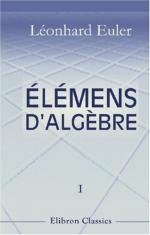|
This section contains 390 words (approx. 2 pages at 300 words per page) |

|
The noted mathematician Leonhard Euler (1707–1783) is remembered in logic chiefly for his geometrical illustrations of syllogistic, "Euler's diagrams" or "Euler's circles." Similar devices were used by J. C. Sturm (1661), Leibniz (see Bocheński, History of Formal Logic, plate facing p. 260), Joachim Lange (1712), and Gottfried Ploucquet (1759), and in a very general way the idea of spatial illustration goes back at least to Juan Luis Vives, who used triangles to illustrate the Barbara syllogism ("De Censura Veri," in Opera, Basel, 1555). But because of Euler's fame as a mathematician and the popularity of his charming Lettres à une princesse d'Allemagne (the relevant letters are CII ff., dated 1761) such diagrams are traditionally named for him.
Euler used proper inclusion for the universal affirmative proposition, exclusion for the universal negative, and intersection for both the particulars. If his interpretation is followed systematically, it correctly decides the validity or invalidity of all three-term syllogisms with...
|
This section contains 390 words (approx. 2 pages at 300 words per page) |

|


